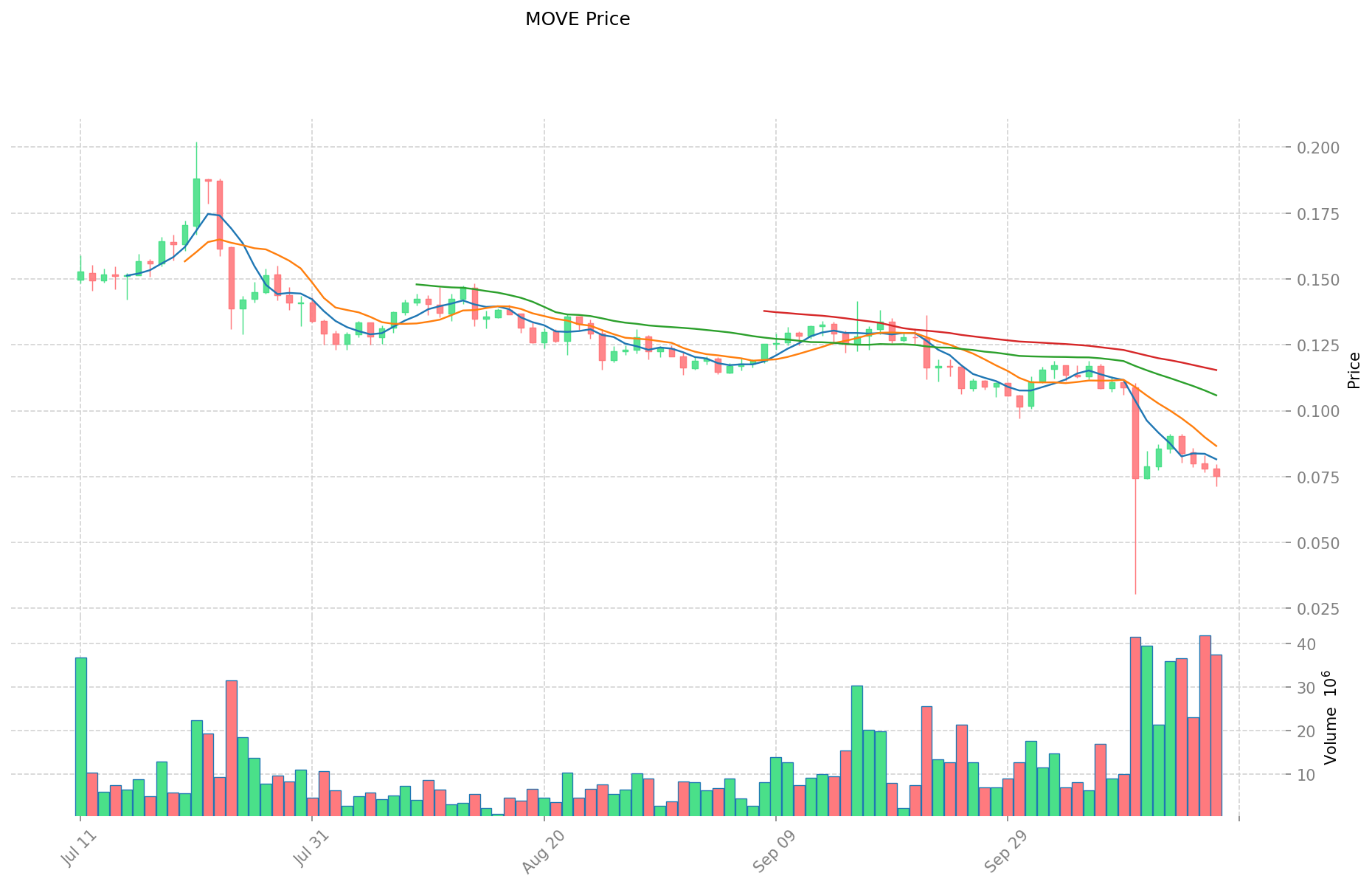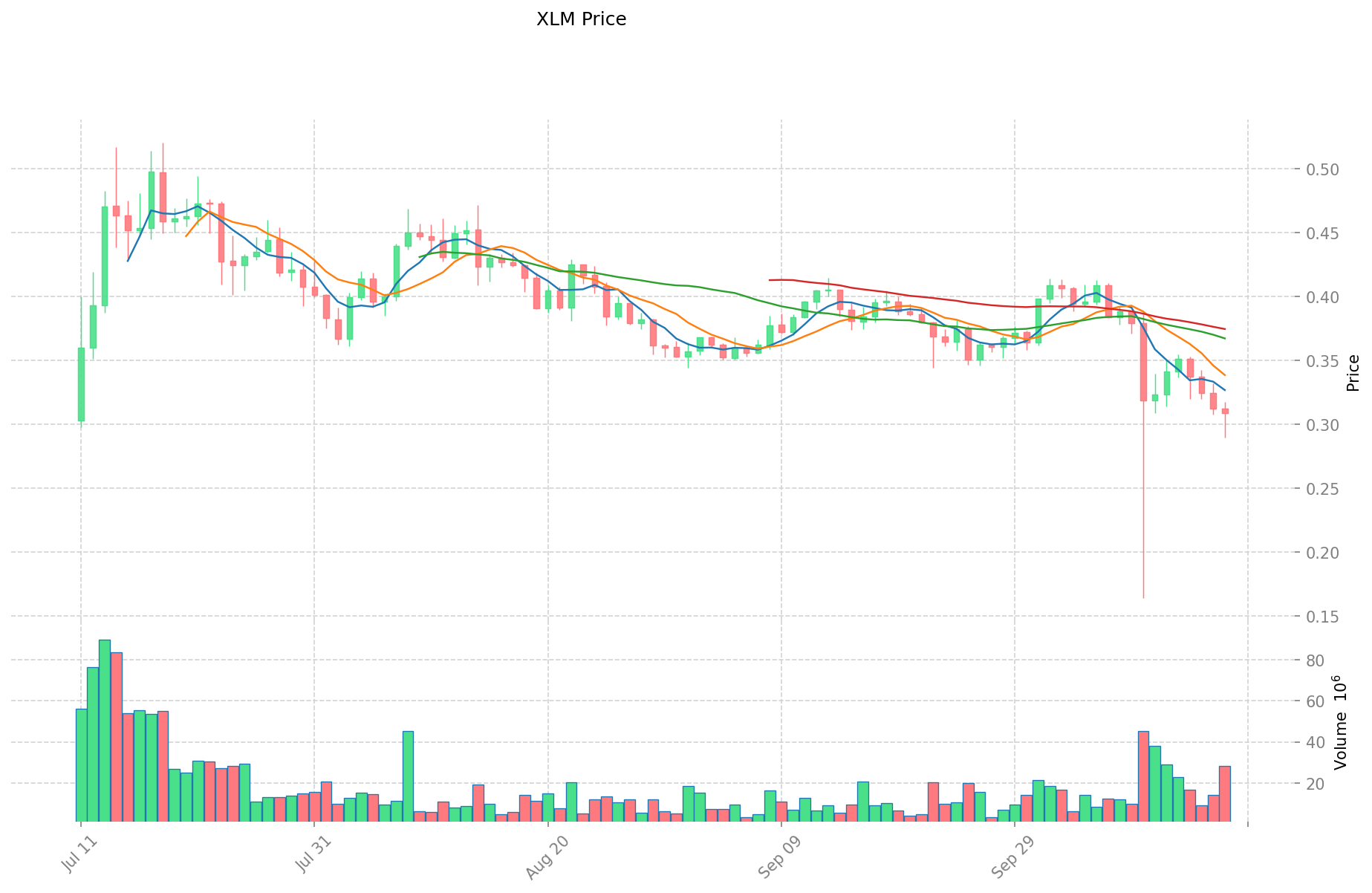MOVE ve XLM: İki Yenilikçi Blockchain Programlama Dili Karşılaştırması


Giriş: MOVE ve XLM Yatırım Karşılaştırması
Kripto para piyasasında Movement Network (MOVE) ile Stellar (XLM) karşılaştırması, yatırımcılar için öne çıkan başlıca konulardan biri haline gelmiştir. Her iki varlık, piyasa değeri sıralaması, kullanım alanları ve fiyat performansı bakımından belirgin farklılıklar gösterirken; kripto varlık ekosisteminde de farklı stratejik konumlara sahiptir.
Stellar (XLM): 2014’te piyasaya çıktığından beri sınır ötesi ödemelerdeki yüksek verimliliğiyle piyasa tarafından tanınmıştır.
Movement Network (MOVE): 2024’te sunulan MOVE, Move ve EVM ekosistemleri arasındaki entegrasyonu sağlayarak öne çıkmıştır.
Bu makalede MOVE ve XLM’in yatırım değerine dair karşılaştırmalı analiz, geçmiş fiyat trendleri, arz mekanizmaları, kurumsal benimseme, teknolojik ekosistem ve gelecek tahminleri üzerinden kapsamlı şekilde ele alınacak; yatırımcıların en çok merak ettiği şu soruya yanıt aranacaktır:
"Şu anda hangisi daha avantajlı bir alım?"
I. Fiyat Geçmişi Karşılaştırması ve Güncel Piyasa Durumu
MOVE (Coin A) ve XLM (Coin B) Tarihsel Fiyat Eğilimleri
- 2024: MOVE, 9 Aralık 2024’te $1,34 ile tüm zamanların en yüksek seviyesine ulaştı.
- 2018: XLM, 3 Ocak 2018’de $0,875563 ile zirveye çıktı.
- Kıyaslama: Son piyasa döngüsünde MOVE, $1,34’ten $0,03033’e geriledi; XLM ise daha istikrarlı bir seyir izleyerek şu anda $0,30965 seviyesinde işlem görmektedir.
Güncel Piyasa Durumu (18 Ekim 2025)
- MOVE güncel fiyatı: $0,0749
- XLM güncel fiyatı: $0,30965
- 24 saatlik işlem hacmi: $2.794.122,81 (MOVE) ve $8.672.445,04 (XLM)
- Piyasa Duyarlılığı Endeksi (Korku & Açgözlülük): 23 (Aşırı Korku)
Canlı fiyatları görüntülemek için tıklayın:
- MOVE güncel fiyatı Piyasa Fiyatı
- XLM güncel fiyatı Piyasa Fiyatı


II. MOVE ve XLM Yatırım Değerini Belirleyen Temel Etkenler
Arz Mekanizmalarının Karşılaştırılması (Tokenomik)
- MOVE: Toplam arzı 10 milyar token ile sabittir; %40’ı ekosistem ve geliştirme için ayrılmıştır
- XLM: Başlangıçta 100 milyar sabit arz ile piyasaya çıkmış, 2024’e kadar yıllık %1 enflasyon uygulanmıştır; 2024’te topluluk oylamasıyla enflasyon kaldırılmıştır
- 📌 Tarihsel eğilim: MOVE gibi sabit arzlı tokenlar, yükseliş dönemlerinde daha yüksek fiyat dalgalanması gösterirken; XLM’nin eski enflasyon modeli fiyat istikrarı sağlarken yükseliş potansiyelini sınırlamıştır
Kurumsal Benimseme ve Piyasa Uygulamaları
- Kurumsal portföy: XLM, IBM ve Deloitte gibi global kuruluşlarla güçlü iş birliklerine sahipken; MOVE, yeni bir token olarak kurumsal alanda henüz sınırlı varlığa sahiptir
- Kurumsal kullanım: XLM, Stellar ağı üzerinden sınır ötesi ödemelerde yaygın şekilde kullanılmaktadır; MOVE ise Move ekosistemiyle mobil ödeme ve oyun sektörüne odaklanıyor
- Düzenleyici yaklaşım: XLM, Stellar Development Foundation’ın proaktif regülasyon politikasıyla farklı ülkelerde avantaj sağlarken; MOVE’un regülasyon durumu ülkeye göre farklılık gösterebilir
Teknik Gelişim ve Ekosistem Oluşturma
- MOVE teknik yenilikleri: Move VM entegrasyonu ile güvenli ve doğrulanabilir akıllı sözleşmeler sunuyor
- XLM teknik gelişimi: Soroban akıllı sözleşme platformu sayesinde Stellar, basit ödemelerin ötesinde programlanabilirlik kabiliyeti kazanmıştır
- Ekosistem karşılaştırması: XLM, sınır ötesi ödemeler ve havale alanında olgun bir ekosisteme sahipken; MOVE, oyun ve Web3 mobil ödeme çözümlerinde potansiyelini artırmaktadır
Makroekonomik Etkenler ve Piyasa Döngüleri
- Enflasyon ortamı: XLM, kripto para piyasasında enflasyon göstergelerine düşük korelasyon gösteren varlıklardan biridir
- Makro para politikası: Her iki token da faiz, döviz ve likidite koşullarına duyarlıdır; XLM, piyasa düşüşlerinde daha istikrarlı bir profil sergilemiştir
- Jeopolitik faktörler: XLM’nin sınır ötesi ödemelere odaklanması, küresel havale talebindeki artışla desteklenebilir; MOVE’un başarısı ise ilgili teknolojik uygulamaların benimsenmesine bağlıdır
III. 2025-2030 Fiyat Tahmini: MOVE ve XLM
Kısa Vadeli Tahmin (2025)
- MOVE: Temkinli $0,0500 - $0,0747 | İyimser $0,0747 - $0,0919
- XLM: Temkinli $0,2821 - $0,3100 | İyimser $0,3100 - $0,4495
Orta Vadeli Tahmin (2027)
- MOVE, büyümeye geçebilir ve fiyatı $0,0814 - $0,1264 aralığında beklenebilir
- XLM, yükseliş dönemine girerek $0,3782 - $0,5742 bandına çıkabilir
- Başlıca etkenler: Kurumsal yatırım, ETF gelişmeleri, ekosistem büyümesi
Uzun Vadeli Tahmin (2030)
- MOVE: Temel senaryo $0,1134 - $0,1260 | İyimser senaryo $0,1260 - $0,1562
- XLM: Temel senaryo $0,3926 - $0,6768 | İyimser senaryo $0,6768 - $0,8190
Yasal Uyarı: Bu tahminler, geçmiş veriler ve piyasa analizine dayanmaktadır. Kripto para piyasaları son derece oynak olup anlık değişiklikler gösterebilir. Buradaki bilgiler yatırım tavsiyesi değildir. Yatırım kararı almadan önce mutlaka kendi araştırmanızı yapınız.
MOVE:
| Yıl | Tahmini En Yüksek Fiyat | Tahmini Ortalama Fiyat | Tahmini En Düşük Fiyat | Fiyat Değişimi (%) |
|---|---|---|---|---|
| 2025 | 0,0918687 | 0,07469 | 0,0500423 | 0 |
| 2026 | 0,108263155 | 0,08327935 | 0,04996761 | 11 |
| 2027 | 0,1264180533 | 0,0957712525 | 0,081405564625 | 27 |
| 2028 | 0,12220411819 | 0,1110946529 | 0,091097615378 | 48 |
| 2029 | 0,1353132872322 | 0,116649385545 | 0,0839875575924 | 55 |
| 2030 | 0,156216857121864 | 0,1259813363886 | 0,11338320274974 | 68 |
XLM:
| Yıl | Tahmini En Yüksek Fiyat | Tahmini Ortalama Fiyat | Tahmini En Düşük Fiyat | Fiyat Değişimi (%) |
|---|---|---|---|---|
| 2025 | 0,4495 | 0,31 | 0,2821 | 0 |
| 2026 | 0,53165 | 0,37975 | 0,21266 | 22 |
| 2027 | 0,574182 | 0,4557 | 0,378231 | 47 |
| 2028 | 0,76211268 | 0,514941 | 0,31411401 | 66 |
| 2029 | 0,7151500608 | 0,63852684 | 0,4597393248 | 106 |
| 2030 | 0,818974524984 | 0,6768384504 | 0,392566301232 | 118 |
IV. Yatırım Stratejisi Karşılaştırması: MOVE ve XLM
Uzun Vadeli ve Kısa Vadeli Yatırım Stratejileri
- MOVE: Oyun ve Web3 mobil ödeme odaklı yatırımcılar için daha uygun
- XLM: İstikrar ve sınır ötesi ödeme çözümlerine erişmek isteyen yatırımcılar için ideal
Risk Yönetimi ve Varlık Dağılımı
- Temkinli yatırımcılar: MOVE %20, XLM %80
- Aggresif yatırımcılar: MOVE %60, XLM %40
- Koruma araçları: Stablecoin portföyü, opsiyon kullanımı, çapraz döviz sepeti
V. Potansiyel Risk Karşılaştırması
Piyasa Riskleri
- MOVE: Düşük piyasa değeri ve işlem hacmi nedeniyle yüksek volatilite
- XLM: Sınır ötesi ödeme sektöründe piyasa doygunluğu riski
Teknik Riskler
- MOVE: Ölçeklenebilirlik ve ağ kararlılığı
- XLM: Merkezileşme ve akıllı sözleşme güvenliği ile ilgili olası riskler
Düzenleyici Riskler
- Küresel regülasyon politikalarının her iki varlık üzerinde farklı etkileri olabilir. XLM, köklü varlığı ve uyum yaklaşımı ile daha az inceleme riski taşır
VI. Sonuç: Hangisi Daha Avantajlı?
📌 Yatırım Değeri Özeti:
- MOVE’nin avantajları: Oyun ve Web3 mobil ödemede güçlü büyüme potansiyeli, sabit arz sınırı
- XLM’nin avantajları: Kurulu sınır ötesi ödeme ağı, kurumsal iş birlikleri, fiyat istikrarı
✅ Yatırım Tavsiyesi:
- Yeni yatırımcılar: İstikrar arayanlar için XLM ağırlıklı bir portföy önerilir
- Deneyimli yatırımcılar: Risk profiline göre MOVE ve XLM’i dengeli portföyde tutabilir
- Kurumsal yatırımcılar: Network ve iş birlikleri nedeniyle XLM’e odaklanırken, yeni teknolojiye maruz kalmak için MOVE’a küçük bir pay ayırabilir
⚠️ Risk Uyarısı: Kripto para piyasası yüksek volatiliteye sahiptir. Bu içerik yatırım tavsiyesi değildir. None
VII. Sıkça Sorulan Sorular
S1: MOVE ve XLM arasında arz mekanizması bakımından temel farklar nelerdir? C: MOVE’un toplam arzı 10 milyar token ile sabittir ve %40’ı ekosistem ile geliştirmeye ayrılmıştır. XLM ise başlangıçta 100 milyar sabit arza ve yıllık %1 enflasyona sahipken, 2024’te topluluk kararıyla enflasyon kaldırılmıştır.
S2: MOVE ve XLM kurumsal benimsemede nasıl karşılaştırılır? C: XLM, IBM ve Deloitte gibi büyük kurumlarla güçlü ortaklıklara sahipken; MOVE, yeni bir token olarak kurumsal alanda henüz sınırlı varlığa sahiptir.
S3: MOVE ve XLM’deki temel teknik gelişmeler nelerdir? C: MOVE, Move VM entegrasyonu ile güvenli ve doğrulanabilir akıllı sözleşmeler sunarken; XLM, Soroban akıllı sözleşme platformunu devreye alarak Stellar’ın programlanabilirliğini artırmıştır.
S4: 2025 kısa vadeli fiyat tahminleri MOVE ve XLM için nasıl karşılaştırılır? C: MOVE için temkinli tahmin $0,0500 - $0,0747; iyimser tahmin $0,0747 - $0,0919. XLM için temkinli tahmin $0,2821 - $0,3100; iyimser tahmin $0,3100 - $0,4495 aralığındadır.
S5: MOVE ve XLM yatırımlarındaki başlıca risk faktörleri nelerdir? C: MOVE, düşük piyasa değeri ve işlem hacmine bağlı olarak daha yüksek volatilite ve ölçeklenebilirlik ile ağ kararlılığı riskleri taşır. XLM’de ise piyasa doygunluğu ve merkezileşme riskleri öne çıkmaktadır.
S6: Risk toleransına göre MOVE ve XLM portföy dağılımı nasıl olmalı? C: Temkinli yatırımcılar MOVE’a %20, XLM’e %80 ayırırken; agresif yatırımcılar %60 MOVE ve %40 XLM seçebilir.
S7: Farklı yatırımcı tipleri için hangi varlık daha uygun? C: Yeni yatırımcılar istikrar için XLM’i tercih edebilir. Deneyimli yatırımcılar MOVE ve XLM’i dengeli portföyde değerlendirebilir. Kurumsal yatırımcılar ise network ve iş birlikleri nedeniyle XLM’e odaklanırken, yeni teknolojilere maruz kalmak için MOVE’a küçük bir pay ayırabilir.

2025 AMP Fiyat Tahmini: Kripto Para Yatırımcılarına Yönelik Stratejik Analiz ve Piyasa Görünümü

2025 REQ Fiyat Tahmini: Request Network için piyasa trendleri ve olası büyüme faktörlerinin analizi

2025 WPAY Fiyat Tahmini: Dijital ödeme token’ının gelecekteki büyüme potansiyeli ve piyasa eğilimleri üzerine analiz

2025 UTK Fiyat Tahmini: Dijital ödeme ekosisteminin gelişimiyle birlikte UTRUST Token'ın büyüme potansiyelini ve piyasa trendlerini analiz etmek

P ve XLM: Gelişmekte Olan Piyasalarda Yatırım Performansına İlişkin Kapsamlı Bir Analiz

UNA ve XLM: Sınır ötesi işlemlerde kullanılan iki yenilikçi blockchain protokolünün karşılaştırılması

Dropee Günlük Kombinasyonu 11 Aralık 2025

Tomarket Günlük Kombinasyonu 11 Aralık 2025

Merkeziyetsiz Finans'ta Geçici Kayıp Nedir?

Kripto Parada Çifte Harcama: Önleme Stratejileri

Kripto Ticaretinde Wyckoff Yönteminin Anlaşılması





